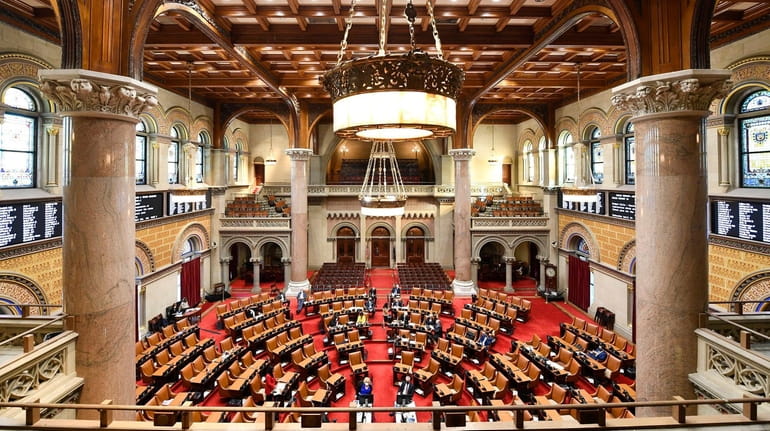Redistricting referendum could extend Democratic enrollment advantage

Members of the New York Assembly debate budget bills at the State Capitol on April 7 in Albany. Credit: AP/Hans Pennink
ALBANY — Sixty-eight words in a ballot question to voters this fall could help seal the Democrats’ enrollment advantage for the next decade in state legislative and congressional elections through a constitutional amendment that would change how election districts are drawn, according to analysts.
The proposal by Democrats who now control the Senate and Assembly also rescinds some protections forced into the redistricting process by Republicans six years ago when they controlled the Senate.
Proposal 1 to voters is the second ballot proposition since 2014 to deal with redistricting. That’s the process of redrawing election district lines every 10 years based on U.S. Census data.
Researchers have long said redistricting is the basis of political power in state government and in the state’s congressional delegation because the party in power in the Senate and Assembly have traditionally drawn their own lines, changing district boundaries to include stacking more of their party members to enhance the prospects of winning an election. That limits competitive elections and helps extend incumbents’ time in office. The shape of some districts have been so contorted that they have been derisively described as the "Long Island Lobster Claw" or the "Long Island Crocodile."
Assembly District 13 was dubbed the Lobster Claw by good government groups in 2014. The shape of the district in the northeast corner of Nassau County was approved by the Assembly’s Democratic majority. It includes Democratic areas of Glen Cove, Woodbury and Jericho surrounding — claw-like — and excluding an open area of Republican neighborhoods in East Norwich and Upper Brookville.
Senate District 3 in Suffolk County, drawn by the Republican majority in the Senate, was called the Crocodile. The body is formed by connecting mostly Republican communities from Shirley to Brentwood. But excluded from the district and in the open jaws of the "crocodile" is half of the community of Brentwood, which was split into two districts, thus reducing its clout at the polls.
Voters who read Proposition 1 this fall will see only a broad description of the proposal: "This proposed constitutional amendment would freeze the number of state senators at 63, amend the process for the counting of the state’s population, delete certain provisions that violate the United States Constitution, repeal and amend certain requirements for the appointment of the co-executive directors of the redistricting commission and amend the manner of drawing district lines for congressional and state legislative offices. Shall the proposed amendment be approved?"
But the legislation behind that question indicates what the specific impacts are:
Changing the vote threshold
Currently, when the Senate and Assembly are controlled by the same party, the constitution requires a two-thirds vote for the Legislature to adopt a redistricting plan if the Legislature rejects proposals by its appointed redistricting commission. That was established in a 2014 constitutional amendment when Republicans controlled the Senate and Democrats controlled the Assembly. But the proposition to voters this fall would reduce that threshold to a 60% vote even if one party controls the Senate and Assembly, as Democrats do now. Democrats have since reached a two-third majority in the full Legislature, but barely. Just a few races in coming elections could change that.
Protection for immigrants, inmates
This fall’s proposition also would give constitutional protection to count immigrants in the country illegally as residents when drawing new election districts and to make sure that prisoners are counted as residents of their latest neighborhood, not their prison. Currently, the Census already counts immigrants in the country illegally, but former President Donald Trump tried unsuccessfully to change that. This proposition would prevent the federal government from excluding them from the New York count in the future. On the prisoner issue, a recent New York law, approved by Democrats, already counts them for redistricting purposes from their last home, not their prison address. The proposition would give this measure the substantial strength of the state constitution and make it difficult to change in Washington or in Albany.
Freeze the number of Senate seats
The number of seats in the Senate would be frozen at 63. That would eliminate a tool the Republican majority at the time wielded in 2012 when they added a 63rd seat to the Senate and located it in a GOP-stronghold in Western New York to bolster their slim majority.
"Republicans are effectively cut out of the process either way, whether the amendment passes or not," said Shawn J. Donahue, a political-science professor who studies redistricting at the University at Buffalo. "The proposed amendment makes it much easier for Democrats to adopt maps that benefit themselves. With the large legislative majorities, there is little incentive for the Democrats on the commission to cooperate with Republicans, since not agreeing on maps gives Democrats sole power over redistricting."
This year, redistricting will be done under a state government that is controlled by a single party for the first time since the 1970s and during a deepening partisan divide in Albany. New district lines are scheduled to be adopted next year before the statewide, legislative and congressional elections.
"Like everything else under Democrat control in New York, this process is a political sham built on a foundation of lies and hypocrisy," said state Republican Chairman Nick Langworthy. "They are going to stonewall and drag this process out hoping New Yorkers aren’t paying attention so partisan legislators can draw their own maps. We intend to employ every legal and political tool in our arsenal to stop them."
Democrats say they are trying to remove a partisan bias Republicans enacted in the constitutional amendment passed in 2014.
"It is pretty comical that the party that made gerrymandering and voting suppression part of their platform are giving advice about redistricting," said Mike Murphy, communications director for the Senate’s Democratic majority. "This amendment will improve the redistricting process, increase transparency, and help ensure New York leads the nation on having fair, impartial lines drawn for state and Federal candidates over the next decade. We believe voters should be empowered to pick their representatives; unfortunately Republicans have always felt that they should be allowed to pick their voters."
Democrats have a more than 2:1 enrollment advantage over Republicans statewide and last year, for the first time, the number of voters who chose not to enroll in any party surpassed the enrollment of the Republican Party in New York.
Attempts to make redistricting independent of political control so that New Yorkers benefit from more competitive elections have been thwarted by "the hyperpartisan nature of the process," said Gerald Benjamin, retired political science professor at the State University of New York at New Paltz who has long studied state government.
"False reform in the guise of reform is the worst possible outcome, as it allows credit-taking for change without results," Benjamin said. "It was not meant to work and it isn’t working … there is no compromise on a bipartisan or nonpartisan basis."
The proposition doesn’t address the basic changes to redistricting that are needed, said Blair Horner of the New York Public Interest Research Group.
"The whole system of redistricting should be run by professional, nonpartisan administrators whose only claim to fame is they know how to do it right," Horner said. The State Legislature has tweaked the redistricting system many times and created what legislators call an independent redistricting commission. But legislative leaders appoint the members of the commission and if the Legislature rejects the commission’s recommendations, the majority conferences of the Legislature can still redraw its own lines.
"It isn’t truly independent," Horner said.
Still, NYPIRG and the good-government groups Common Cause-NY and Reinvent Albany support Proposition 1. Horner argues that the Legislature so far has shown no interest in creating a truly nonpartisan process, so the smaller improvements such as assuring prisoners are counted at their last home address are worth passing.
"While the resolution overall improves the redistricting process established in 2014," the good-government advocates said in a statement, "it could be significantly strengthened with reforms needed to ensure fair and independent redistricting."
Horner said advocates don’t dispute the Republicans’ concerns, "but at the end of the day, whether there are Democratic or Republican supermajorities is up to the voters."
Not all advocates agree.
"While we do support the clauses about undocumented immigrants and the counting of prisoners at their home addresses, we believe that diminishing the influence of the minority party in the redistricting process is reason enough to reject this proposal," said Laura Ladd Bierman, executive director of the League of Women Voters.

